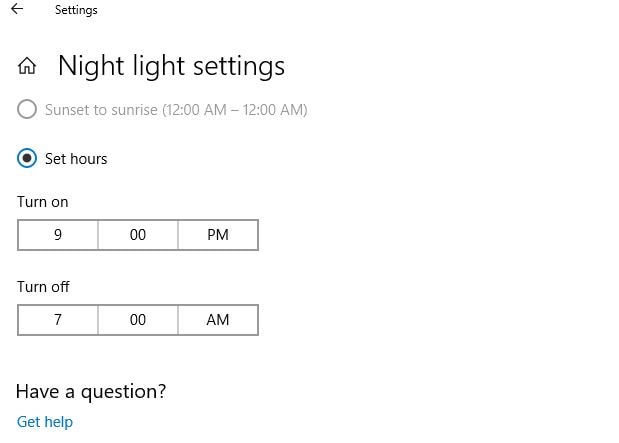Windows 10 Night Light feature is designed to filter out harmful blue light from your computer display and replace it with warmer colors which reduce eye strain and help you sleep. It works just like Night Shift on the iPhone and Mac, Night Mode on Android, Blue Shade on Amazon’s Fire tablets. Enabling this feature should reduce eye strain and minimize the negative effects that long hours in front of a computer can have on your sleep. The feature can be turned on manually as needed, or configured to automatically turn on gradually as the day goes on. let’s take look How to enable and configure Windows 10 Night Light feature.
Enable Windows 10 Night Light feature
To activate the Windows 10 Night Light feature,
- Open the Windows Settings screen using Windows + I
- Click or tap the System category
- Then select the Display tab in the left navigation bar
- On the right of the Settings window, find the section called Color and turn On the Night lightswitch.
Windows 10 Night Light settings
By default, the Nightlight mode will be scheduled to activate between sunset and sunrise. For more advanced control, click Night Light Settings, right under the Nightlight switch.
In the Nightlight settings, you will get a short explanation about the fact that “Screens emit blue light, which can keep you up at night. Nightlight displays warmer colors to help you sleep”. Then, you get a switch that does the same thing as the one before: turn the Night light mode On or Off.
Then, you will see a slider called “Color temperature at night.” Dragging this slider to the left or the right will make your screen use warmer, yellowish colors to reduce eye strain, or the regular cooler and blueish colors. Play a bit with this slider and see what’s the color temperature that feels best to you at night. If you do this at night, it shouldn’t be too hard to find the right setting, where you can feel your eyes begin to relax a bit.
In the same “Nightlight settings“ window, right after the “Color temperature at night” slider, you see a section called Schedule. If you turned the Nightlight On, the Schedule Night lightswitch will be On and set to be applied between Sunset to sunrise. The exact time of sunset and sunrise is automatically calculated by Windows 10 depending on your location.
Also, click the Set hours radio button. The screen will add a section where you can set a schedule that fits your preferences and work patterns.
Activating the Windows 10 Night Light feature could improve your ability to sleep when the work is done.
Windows 10 Night Light Not Working
If you found Windows 10 Night Light Not Working, Night Light Options Are Grayed Out, Not enable automatically even you have scheduled to turn on during night time. Here some solutions you may apply.
Press Windows + R, type regedit and ok to open the windows registry editor.
First Backup registry database then navigates to:
HKEY_CURRENT_USER\Software\Microsoft\Windows\CurrentVersion\CloudStore\Store\Cache\DefaultAccount
Expand the DefaultAccount registry folder, and then delete the sub-folder labeled $$windows.data.bluelightreduction.bluelightreductionstate.
Next, delete the sub-folder labeled $$windows.data.bluelightreduction.settings located just below the previous one.
That’s all Exit the Registry Editor and restart your PC. Check Windows 10 Night Light working.
Also, Read
- How to Open HEIC file (iPhone images) in Windows 10 Or convert heic to jpg
- Fix MACHINE_CHECK_EXCEPTION BSOD error On Windows 10
- Solved: WiFi Keeps Disconnecting After Windows 10 1809 update
- How To Fix Boot Error 0xc000000e On Windows 10 1809 update
- 10 Warning Signs that Your Windows 10 is Virus Malware Infected




